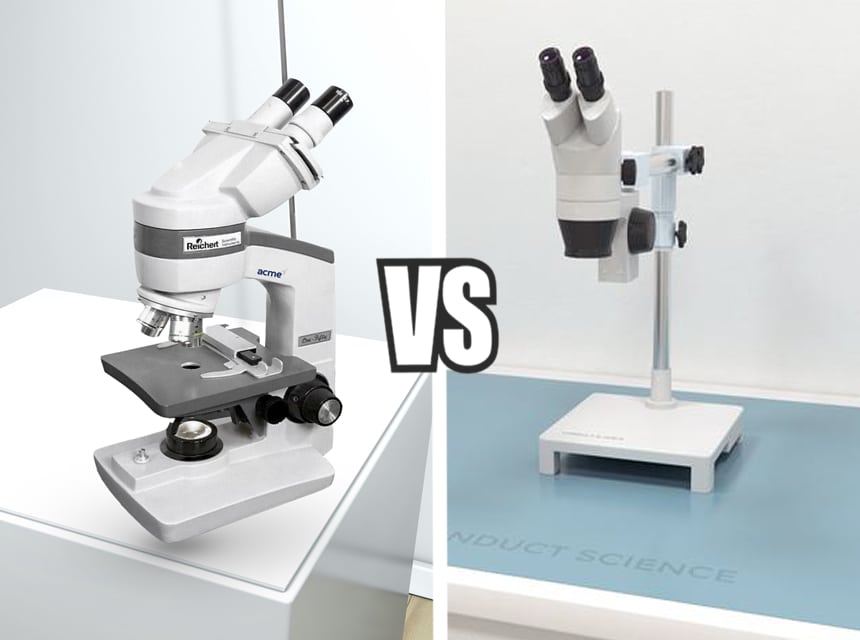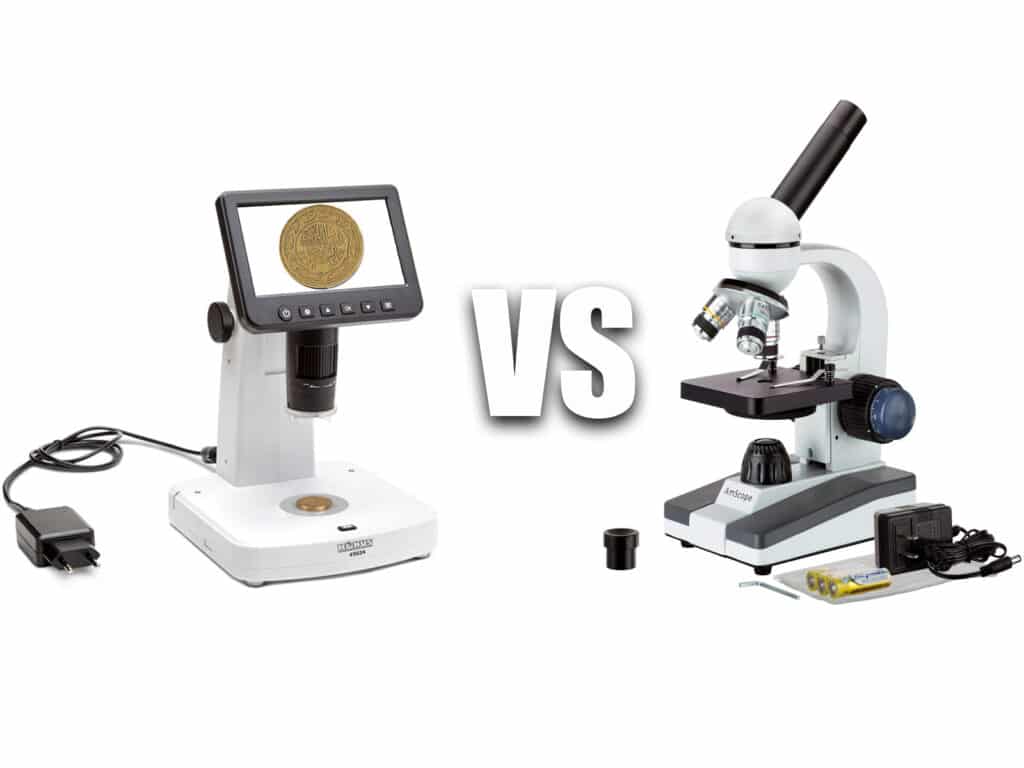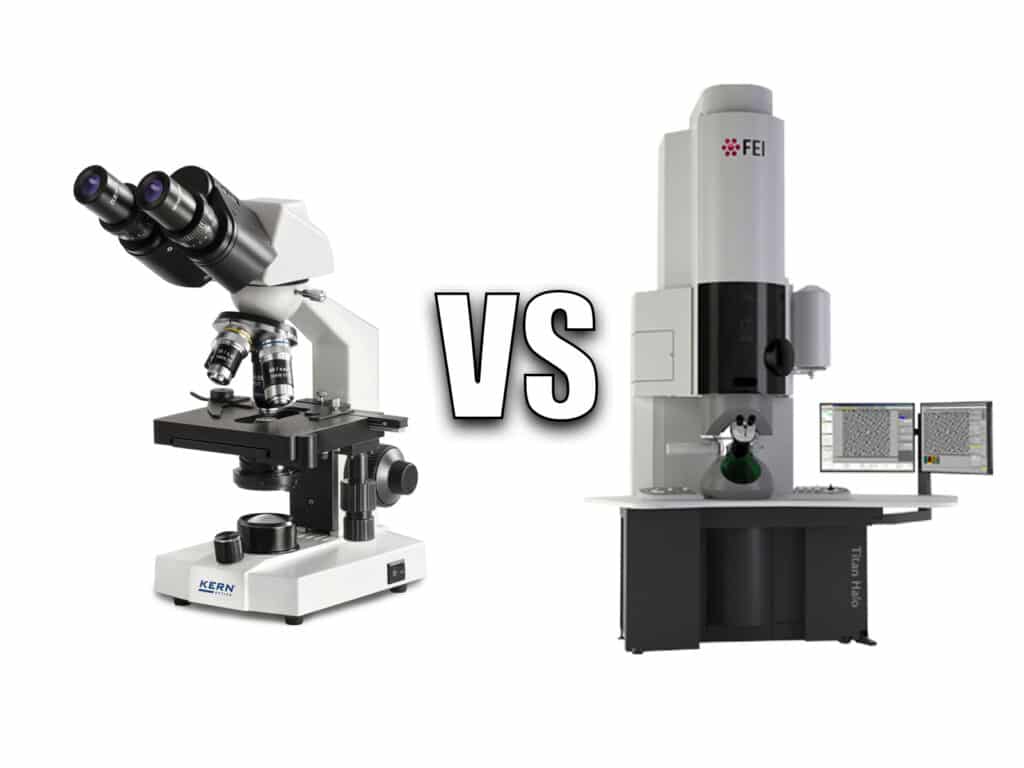

A coin microscope is a critical collector’s tool for viewing and grading coins. A good fan of numismatics does not need a lot of magnification. A range of x20 to 60x is ideal for this study. To be able to view the coins well, it is good to do it with an intense light source. The use of a stereoscopic microscope is an ideal option to be able to view it in the comfort of your home or in a study.
On the other hand, with a USB microscope, you can easily see the images of your coins on your computer or mobile screen and thus easily take pictures. These images can be enlarged to share them or study details of a coin. So, between the USB or stereoscopic one, which is the best microscope for coins?
To decide, you have to check out our reviews of the best microscope for viewing coins. The 5 products which we are going to recommend were picked based on certain criteria which a numismatist or a hobbyist should focus on. These include the focus range, light source, magnification, PC and software requirements, dimensions, and weight.
With its magnification of up to 250 times, the Plugable Digital Microscope will satisfy enthusiasts, students, and professionals alike. Easy to assemble and easy to use, it connects to a computer, smartphone, or tablet via a 1.2 m USB 2.0 cable. The resulting image has a resolution of 1600 x 1200 p. You can also record video at 640 x 480 p.
For good observation quality, lighting is provided by integrated LEDs, the light of which passes through a diffuser. This prevents glare when you want to magnify the image of an object with a smooth surface. This digital microscope incorporates the image capture function via a touch button that gives sharp images. Note that the microscope body is connected to a suction cup via a flexible gooseneck.
The Plugable USB2-MICRO-250X is as portable as it is affordable. With 250X magnification, it obviously can’t get close enough to examine bacteria (like microscopes with 400X magnification and above might). But it’s pretty impressive when used for coin collection as it is best for viewing larger samples like coins or stamps.
With your computer, you can easily control the function of the camera. Aspects like capture resolution and exposure are easy to adjust. There are also video and time-lapse functions if your sample changes over time. In our opinion, it is the best USB microscope for coins.
What we liked: The Plugable USB 2.0 is our best digital microscope as it is easy to use and offers good magnification performance. It works with all operating systems and mobile devices. There are built-in LED lights that are adjustable via a dial. Something you don’t see in a lot of microscopes is that the lights shine through a diffuser (which helps reduce glare – especially useful when looking at samples that reflect light).
What could be better: The microscope with a stand could be more stable. Also, it only works via a USB port. Finally, although the magnification is great for coin collection, it’s not suitable for viewing smaller objects or microorganisms like bacteria. So, it’s not versatile.
Magnifiable up to x1000, this digital and portable microscope is perfect for coin viewing. It is also very useful for students and inventors who need to enlarge the image of things studied. The best thing about this model is that it is compatible with Android, Windows, Mac, and Linux. It allows you to use it with total freedom.
It also has 8 LED lighting adjustable for brightness. So you can increase or decrease as required, you can also adjust the focus to view the details you need. It is ideal for inventors, numismatists, children, and engineers.
Although very compact, it surprises us with its qualities and functions. The device is compatible with Mac OS X 10.5, Windows 7, Android, and Linux. But if you have an iPhone, you will not be able to use it with it.
The USB x1000 microscope will allow you to easily observe larger objects like coins, insects, plants, or stones. This 1000x USB microscope comes with free USB microscope software that is very easy to install.
You can make videos, shoot photos with its USB microscope camera. It’s for sharper observations, for looking at objects on your computer and sharing them, and for simple but precise experiments.
What we liked: The microscope is quite functional. It is more than a microscope but like a digital magnifying glass. You can see everything in detail.
What could be better: The software could be better programmed. It came with malware and didn’t work for some users.
With this pocket microscope, you can make magnifications of between 60x – 120x through the lens. You will have a good definition of the details of the object you are studying in this practical and powerful instrument. You can take it wherever you want, thanks to its compact size that allows you to store it in a pocket.
Its lighting system is made up of a set of internal spherical lenses of LED technology. It lets you have a clear view of the details of the object, without any modifications or alteration of colors. Thanks to its powerful light, you can use the microscope even in a dark place and still get an excellent visualization.
The Carson MicroBrite Plus has an incredible magnification quality that makes you see, magnify, and collect your coins. The dynamic and portable design makes this microscope a more comfortable way to view objects. It performs better if the surface you rest it on is flat. The Carson pocket microscope is compatible with the iPhone 5 / 5S and above and Galaxy S4 and above. So, you can connect it to the camera of these devices and see what it projects on their screens.
Its battery function gives you more time of use. Versatile for other use, it is an amazing device for children and adults to develop their curiosity.
What we liked: It’s a handheld device with incredible magnification quality. The Carson model is created so that nothing is overlooked. We like its portable and lightweight design. It also works with an AA battery. So you can take it with you everywhere to observe objects at any time.
What could be better: Some buyers report that it is difficult to use it to focus on very small things. However, after several attempts, you may find the image you want to review.
The FlipView is another good microscope for coins. It is a new model of the portable digital microscope from the collection of the renowned optical equipment manufacturer, Celestron. FlipView is a microscope designed for viewing a wide variety of samples. It can be used to view beach sand, insects, coins and stamps, documents, circuit boards, etc. This new model comes equipped with a 3-inch full-color LCD screen that folds out when needed for perfect portability. It has a rechargeable lithium-ion battery with magnifications from 10x to 120x (300x on PC). It also includes a built-in 5 MP sensor, combined with a 5-element IR cut lens along with an adjustable 8-LED ring illumination system.
It allows you to save all the images and videos on a Micro SD card (up to 32 GB). And the device can be connected to the computer using the USB cable, where you can capture images using Celestron’s software, Capture Pro. Additionally, images captured with FlipView can be sent to a projector or TV with the video-out cable (also included).
What we liked: We like how uniquely designed the Celestron microscope looks. Also, its portable design and rechargeable battery makes it easy to carry and use anywhere. You can use the device with the stand or simply hold it by hand.
What could be better: There is no internal WiFi module, although it is advertised to have this. The software transfers the images to the PC at a ridiculous resolution (640 x 480). In addition, the rotating holder with ball head provided as an accessory is unstable and when shooting an image, the microscope shakes or moves.
With between 50X and 1000X magnification, this TOMLOV DM4 Coin Microscope is excellent not just for inspecting coins but also for other artifacts like plants and stamps. It can also be used to view and repair circuit boards. The best thing about it is the screen. It has a 4.3-inch LCD with which you can view the coins without needing extra equipment. Other components of the design include a metal stand and base.
Also, with its minimal components, it doesn’t take long to put together. That said, you can forego attaching the stand and use it as is, especially if you’re taking it outdoors to view bugs or something similar. The fact that it comes with a 2000 mAh battery built-in means that it should work for more than a few hours without needing to be plugged in.
Focusing is manual, with the focus ring on the lower part of the machine. Nevertheless, it should be pretty easy to use for most people. The small microscope is also capable of capturing photos and video. It ships with a 32 GB SD card, so you have enough storage for the same. Video quality is capped at 720P, and lighting is not an issue. After all, there are eight LEDs as part of the microscope’s setup.
The microscope allows you to connect to a computer with Windows and MacOS compatibility. With that, you can view the magnified object on a much larger computer screen with no extra software needed.
The best digital microscope for coins, the Levenhuk DTX 350 LCD is an optical instrument for making extended observations. With incident light from this system, you can observe coins, seeds, insects, and samples with non-transparent volume. Thanks to its practical LCD screen, it is a very useful and easy-to-operate element. It is suitable for both professional activities, as well as for studying or simply for hobbies.
Image magnification is performed by the microscope, using the built-in digital camera. The image quality is adjusted using the included software. The samples can be attached to the stage using the clamps. The Levenhuk device is illuminated by 8 bright LEDs of adjustable intensity located above the objective. The enlarged image is sent to the integrated LCD screen and can be sent to any larger external screen.
The microscope has a slot for SD cards. You can store images and videos of the observations made with the instrument. It also includes a CD with an image processing program in which you can make adjustments and retouch your images and videos. You can also perform angular and linear measurements and inscriptions on the samples.
In addition to everything inside, the Levenhuk DTX350 microscope gives you a run-time of 7 hours with a full battery charge. The device can also be powered through the USB cable of a computer or the main current if necessary. The AC power adapter is sold separately.
What we liked: The device has an integrated 4.3″ color LCD screen with between 20 to 600x magnification, sufficient for coin viewing. It provides the measurement of linear and angular distances; areas and angles and radii of observed objects. We also like it that it includes an advanced editing software and a built-in battery that is USB-rechargeable.
What could be better: The microscope is not very portable. It is the heaviest in this review, therefore, it lacks portability.
The microscope makes tiny particles visible to our eyes. It’s surprising to think that we can even see bacteria with the help of this equipment, right? Indispensable in health and research laboratories, the microscope is also used in other professions and activities like coin collection. Do you want to know more about them? Continue reading and we will let you know all the main features of this device so you can buy the best model for your need.
A coin microscope is an essential tool for any collector. This instrument will allow you to examine in detail, capture, and document all the coins in your collection. The main advantage of the microscopes for coins is that they are designed to be connected to your PC or smartphone, depending on the model.
Therefore, you will be able to enlarge the image and the observed object for better visibility through the software. It allows you to observe everything that you cannot see with the naked eye. The microscope also allows you to make enlargements on your PC, videos, or screenshots that you can share with other. It is very popular with numismatists.
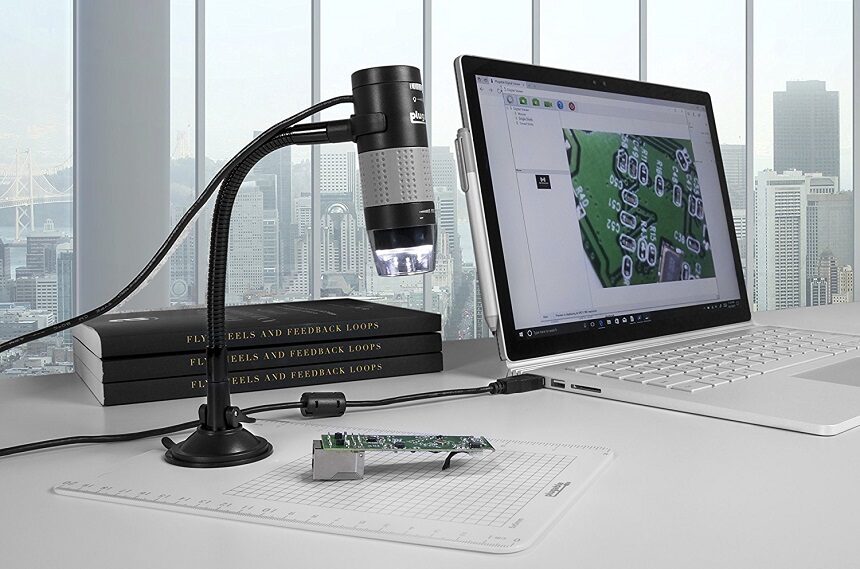
Choosing a microscope for coins is not easy, especially if it is your first purchase and you are just beginning to observe. To buy the right microscope, you must take into account some features. Here are some criteria to consider before purchasing this optical device:
There are three basic types of microscopes that can be used for observing coins. They include:
| Type | Advantage | Drawbacks |
| Stereoscopic | Precision and detail in observations. | Not portable. |
| USB microscope | Allows you to take photos easily. | Needs a computer. |
| Pocket Microscope | Portable, easy to carry. | It is not easy to take photos. |
| Magnifier with light | The easiest to transport and take for example to a market. | x10 maximum magnification. |
Before using a microscope, you need to know the feature and steps that will help you get better results from your samples. Focusing is the most important action in this device. For coin viewing, a focus range from 10mm to 250mm, as you can find in the Jiusion USB Microscope, is optimal. For better focusing, just place the stage on the slide and adjust it. Turn the fine screw to start focusing until the object is visible and turn the fine screw. Turn the micrometer screw to adjust the quality of the focus already made. Analyze the approach down to the smallest detail. Adjust other factors, such as lighting or contrast.
The level of magnification is an important point to take into account. However, it will depend on what you wish to view and how much you need to see. So, it is not worth buying microscopic devices with large magnifications that you will not use, or that will be excessive for observation. On the market, there can be magnifications of 200X, 400X, 500X, 800X, or 1000X. However, in most cases, a magnification range between 20x and 60x is usually sufficient for observing coins. Depending on the details and characteristics that you want to observe, it may be necessary in some cases to have higher magnifications, reaching 100x or 200x.
The magnification of the microscope defines the quality and type of samples that can be observed. The best thing is that you have a device that allows you to change objectives. This gives you versatility when observing.
The full magnification of the compound light microscope occurs in two stages: first at the objective lenses and second at the eyepiece lenses. Thus, it is necessary to know the magnification of the two parts of the microscope to know the total magnification obtained. In any case, microscope magnification = Objective magnification x eye magnification.
The optical quality of the microscope is defined by the eyepiece and the objective. However, the latter is the most important, since it is where most of the magnification occurs in the microscope. Make sure that the objectives are achromatic, as this will be able to correct some visual inaccuracies of the lenses.
In addition to achromatic ones, there are other types of objectives, which you will choose depending on the budget you want to invest. There are the planes. These ones reach an almost perfect level of correction. There are also the semi-planes. They are not as expensive as the planes and have a higher correction level than the achromatic ones.
Another very important feature is the need to scale to analyze the target. To give you an idea, the human eye sees up to 100 micrometers (the unit after millimeters). In the human body, the largest cell in existence is the egg, at 120 microns (so we can see it!). However, it is visible to the naked eye, as a small dot, and nothing else. An optical microscope will be able to give you images with a resolution limit of almost 0.2 microns, which allows an incredible magnification in what you want to observe.
Some can reach a resolution limit of 0.2 nanometers (the unit after the micrometer).
For general knowledge: 1 millimeter equals 1,000 microns, which in turn equals 1,000,000 nanometers.
The electronic microscopes have a digital camera. This is what allows the visualization and the capture of the image of the samples. The quality of the image is decisive within the choice that you are going to make. And this can be divided into two types. The optical gives the perception through pixels that generate the clarity of the image. While the interpolated produces artificial pixels for images taken with the camera. Due to the variety of the products on the market, there are different resolutions: 1.3 megapixels, 2 megapixels, and 5 megapixels, as can be found in the Celestron FlipView.
As we have said, most microscopes have cameras that allow the capture of images and sometimes even video. The Jiusion Digital Microscope and the Levenhuk DTX 350 have these functions. However, many times, the button where the image is captured is very hard to press. So, many times they are blurred or out of focus. Meanwhile, the digital microscopes that come with the ‘microtouch’ are better because capturing the image is easier and accurate.
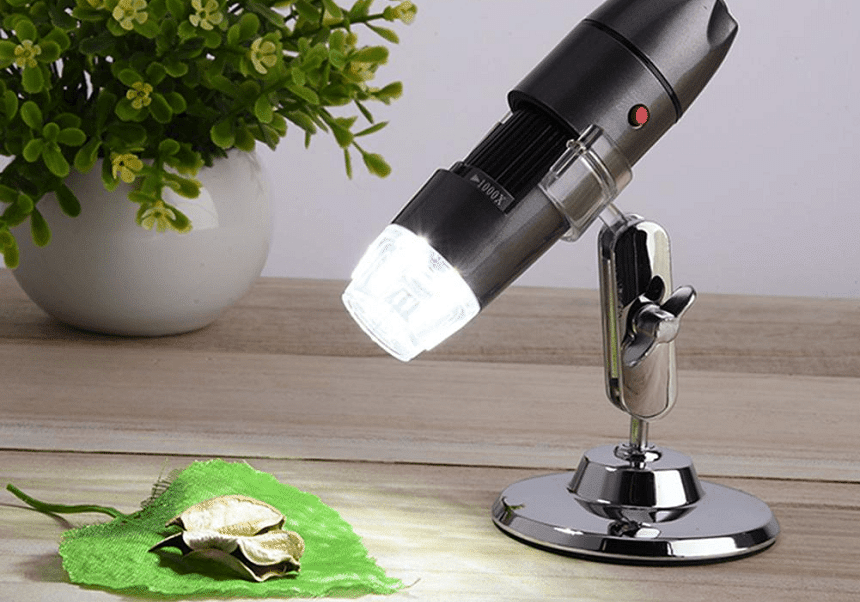
There are four different types of lighting and you can choose one or the other as it suits us. They are tungsten, fluorescent, LED, and halogen. These last two are the ones that contain the highest brightness and quality. Being white light, the heat does not affect the sample. Therefore, they should be used in more sensitive investigations.
Fluorescent is another type of lighting that does not cause any harm. Tungsten, for its part, contains yellow light and its use is recommended in samples that cannot be affected by heat. You must take these factors into account when buying a microscope.
All of the products on this list use some form of adjustable lab LED light. However, the question of proper lighting mainly comes down to how these lights are powered.
Some have two options: plugging the microscope into a power outlet (which is not good for portability) and inserting AA batteries (the Carson MicroBrite Plus model is a model that only works with batteries). Others do not have cords and are rechargeable (such as the Celestron FlipView 5MP) using a rechargeable battery.
Many microscopes today can be easily connected to a laptop and will offer a host of new microscope features to play with. You will need to ask yourself two questions: can I afford this software, and do I really need its advanced features? Software like this will definitely drive up the price. Fortunately, when some microscope manufacturers make these types of microscopes, they usually have an optional microscope camera that you can purchase separately and attach to your telescope eyepiece.
Also, ensure the microscope is compatible with the operating system of your PC or phone. Some are connectible to Windows OS from Vista and up, while some can accept iPhone 5 and above.
Although it is not a technical detail, the dimensions of the device are factors to take into account. This is important especially if you have limited space to place the microscope. In general, these devices do not take up much space, but the height and width vary a lot from one type to another. Therefore, it is worth checking these measurements. There are even mobile phone models that can fit your palm. Please note, do not even buy a product considering only the product photo. When you receive it at home, it may be smaller than imagined. So, ensure you check the dimensions and weight. If you will be always on-the-go, a product like the Celestron FlipView 5MP will be just perfect for you. Microscopes weighing more than 10oz are too heavy and may not be easy to carry everywhere.
So far we have seen the main elements that we must consider before acquiring a specific microscope. But it is also recommended that you pay attention to complementary accessories. These will help you achieve higher levels of quality. This is especially recommended if you are looking for something above average.
The accessories allow, mainly, the obtaining of more accurate results. When we talk about accessories, we mean the possibility of having reflective mirrors or condensers, lens oil, slide dispensers, lens cleaner, carry bag, microscope covers, flow cells, vessel holders, or light cubes.
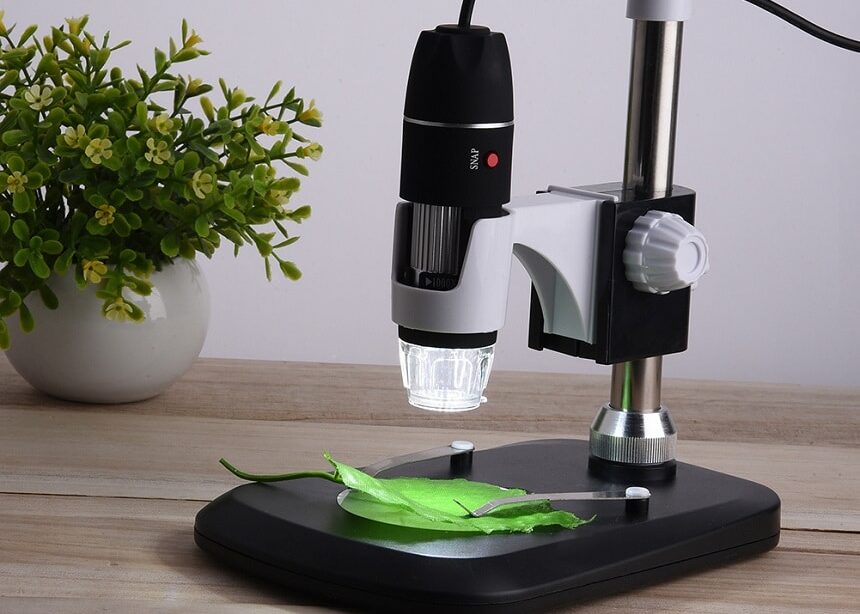
“How much money should I spend on a digital microscope?” It is an important question taking into account the variety on the market. But what will be the best quality-price for a coin microscope? Well, we have left you a brief description here so you know which one is the best.
There are different types of microscopes, but, here, we will focus on the one most common in labs: the compound microscope. First, set the microscope to its lowest magnification on the objective lens (that’s probably 4X). Then place the microscope slide you want to examine on the mechanical stage and secure it with the mechanical stage clips. Use the focus wheel to move the mechanical stage upward until it is as close to the lens as possible without touching it.
Then look through the eyepiece and fine-focus the image until it is sharp. The condenser will need to be adjusted so that the optimum amount of light passes through. You can now switch to a higher wattage lens and readjust the fine focus and capacitor if necessary.
Using a microscope is essential in coin viewing and collection. However, you need to have the best microscope for this. The Plugable Digital Microscope is the overall best and the Editor’s Choice. This microscope is portable and affordable. With 250X magnification, it’s pretty impressive when used for coin collection.
The Jiusion Digital Microscope is the runner-up winner. Magnifiable up to x1000, this digital and portable microscope is perfect for coin viewing and wins the place for the Best Value. The best thing about this model is that it is compatible with Android, Windows, Mac, and Linux. It is ideal for inventors, numismatists, children, and engineers.
Finally, choose our Budget Pick, the Carson MicroBrite Plus, if you want the best microscope for coins that come at an under 20 price. You can make magnifications of between 60x – 120x through the lens. Its lighting system is made up of a set of internal spherical lenses of LED technology. It lets you have a clear view of the details of the object, without any modifications or alteration of colors.

